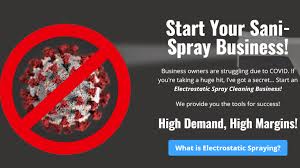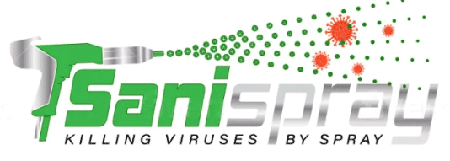What is Electrostatic Spraying?
Electrostatic spraying is a method of applying a coating, cleaner, disinfectant, or other liquid to a surface by applying an electric charge to the liquid solution. Electrostatic spray technology was invented in the 1930s to improve spray disposition. It was popularized in the 1940s by the auto industry, where it was used to more efficiently paint cars and trucks. In the 1980s, the technology emerged in the agriculture industry as a method to apply pesticides to crops. Over the last few years, electrostatic spray technology has found its way into the cleaning industry as an efficient new way for cleaning professionals to apply cleaners, sanitizers, and disinfectants across facility types and surfaces.
Sani-Spray - Electrostatic Spray Cleaning - Business Information
Earn money and help your community by starting a Sani-spray business during COVID-19.

We Provide You the Tools for Success
- Equipment: 1 Handsprayer
- Use of Sanispray Logo
- 500 of each: Business Cards, Handout Flyers
- 4 Tyvek Suits, Rubber Gloves & Masks
- List of 500 Potential Customers
- 3 Page Website
- 1 – 500 Piece Personalized Mailers
- Education eBook
All for just $1795.00 plus a $250 monthly marketing fee.
How Does Electrostatic Spraying Work?
At the most basic level, electrostatic spraying works by applying a positive electric charge to a liquid as it passes through a nozzle. The liquid is then sprayed onto a surface that is grounded or has a negative electric charge. Excess protons in the positively charged atoms of the spray are attracted to the electron fields of other atoms, causing those atoms to become polarized.
Electrostatic spraying provides a full, even coat of liquid across a surface. The droplets will cover the entire visible area, including the underside and backside of surfaces. Surfaces that have already been covered by the disinfectant will repel additional spray, maximizing the efficiency of delivery. Conventional sprayers use air pressure to break down the particles in a liquid solution. This leads to a high spraying velocity that can cause overspray. Electrostatic sprayers do not use air pressure in the atomization process. This leads to a vastly improved transfer efficiency, which limits chemical consumption as well as the release of volatile organic compounds (VOCs) and hazardous air pollutants (HAPs) into the environment.

Disinfectants Used in Electrostatic Sprayers
Since most liquids can be used in electrostatic sprayers, many common disinfectants can be applied using the technology. For use against COVID-19 specifically, the EPA has released “List N: Disinfectants for Use Against SARS-CoV-2”. All of the products on List N meet the EPA’s criteria for use against COVID-19.
From the Owner...
"I’m seeing so many people struggling to keep up with regular billing due to COVID. If you’re taking a huge hit, I’ve got a secret for you…
It’s time to start your Electrostatic Spray Cleaning Business.
Local Businesses need Electrostatic Cleaning Services NOW more than EVER. You’re missing out on a HUGE opportunity to find work and help your community fight Covid-19.
Whether this is your last option before closing your business, or you’re looking to make a healthy profit, you’ll learn everything you need to know to offer sanitization services using EPA approved chemicals.
After 52 years in the Cleaning Business, I’ve never seen a better opportunity. Learn about how you can adapt before it’s too late."
-Wayne Baxtrom




